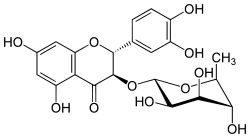Astilbin
Astilbin is a flavanonol, a type of flavonoid. Astilbin is the (2R-trans)-isomer; neoisoastilbin is the (2S-cis)-isomer and isoastilbin is the (2R-cis)-isomer.[2]
 | |
| Names | |
|---|---|
| IUPAC name
(2R,3R)-2-(3,4-dihydroxyphenyl)-5,7-dihydroxy-3-[(2S,3R,4R,5R,6S)-3,4,5-trihydroxy-6-methyloxan-2-yl]oxy-2,3-dihydrochromen-4-one | |
| Other names
Isoastilbin Neoastilbin Neoisoastilbin Taxifolin 3-O-rhamnoside Taxifolin 3-rhamnoside (2R-trans)-3-((6-Deoxy-alpha-L-mannopyranosyl)oxy)-2-(3,4- dihydroxyphenyl)-2,3-dihydro-5,7-dihydroxy-4H-1-benzopyran-4-one[1] | |
| Identifiers | |
3D model (JSmol) |
|
| ChEBI | |
| ChEMBL | |
| ChemSpider | |
| ECHA InfoCard | 100.222.924 |
PubChem CID |
|
| |
| |
| Properties | |
| C21H22O11 | |
| Molar mass | 450.39 g/mol |
| Appearance | brown powder[1] |
Except where otherwise noted, data are given for materials in their standard state (at 25 °C [77 °F], 100 kPa). | |
| Infobox references | |
Natural occurrences
Astilbin can be found in St John's wort (Hypericum perforatum, Clusiaceae, subfamily Hypericoideae, formerly often considered a full family Hypericaceae), in Dimorphandra mollis[3] (Fava d'anta, Fabaceae), in the leaves of Harungana madagascariensis (Hypericaceae),[4] in the rhizome of Astilbe thunbergii,[5] in the root of Astilbe odontophylla[6](Saxifragaceae), in the rhizome of Smilax glabra[7] (Chinaroot, Smilacaceae) and in the bark of Hymenaea martiana.[8]
- in food
It can be isolated from Kohki tea processed from Engelhardtia chrysolepis (huang-qui).[2] It is also present in certain wines.[9]
Uses
Astilbin can act as an insecticide against Anticarsia gemmatalis and Spodoptera frugiperda.[3] It shows in vitro antibacterial activity[4] and activity on burn wound healing.[5] Astilbin is used in traditional Chinese medicine.[6]
Related compounds
3'-O-Methylastilbin shows an immunosuppressive activity against contact dermatitis.[7]
References
- http://anwabio.com/asti.htm%5B%5D
- Astilbin on PubChem
- Biological activity of astilbin from Dimorphandra mollis against Anticarsia gemmatalis and Spodoptera frugiperda, Luciane G Batista Pereira, Fernando Petacci, João B Fernandes, Arlene G Corrêa, Paulo C Vieira 1, M Fátima G F da Silva, Osmar Malaspina, 2002
- Isolation and in vitro antibacterial activity of astilbin, the bioactive flavanone from the leaves of Harungana madagascariensis Lam. ex Poir. (Hypericaceae), B. Moulari, Y. Pellequer, H. Lboutounne, C. Girard, J.-P. Chaumont, J. Millet and F. Muyard,
- Effects of Astilbe thunbergii rhizomes on wound healing: Part 1. Isolation of promotional effectors from Astilbe thunbergii rhizomes on burn wound healing, Yoshiyuki Kimura, Maho Sumiyoshi and Masahiro Sakanaka, 2006
- First synthesis of astilbin, biologically active glycosyl flavonoid isolated from Chinese folk medicine, Ken Ohmori, Hiroki Ohrui and Keisuke Suzuki, 2000
- "Identification of a New Metabolite of Astilbin, 3'-O-Methylastilbin, and Its Immunosuppressive Activity against Contact Dermatitis, Jianming Guo, Feng Qian, Jianxin Li, Qiang Xu, Ting Chen, 2006". Archived from the original on 2011-06-07. Retrieved 2009-08-30.
- Isolation, Chemical Identification and Pharmacological Evaluation of Eucryphin, Astilbin and Engelitin Obtained from the Bark of Hymenaea martiana. Eliane Carneiro, João B. Calixto, Franco Delle Monacheand Rosendo A. Yunes, Pharmaceutical Biology, 1993, Vol. 31, No. 1, Pages 38-46
- Levels of Stilbene Oligomers and Astilbin in French Varietal Wines and in Grapes during Noble Rot Development, Nicolas Landrault, Fabienne Larronde, Jean-Claude Delaunay, Chantal Castagnino, Joseph Vercauteren, Jean-Michel Merillon, Francis Gasc, Gérard Cros and Pierre-Louis Teissedre, J. Agric. Food Chem., 2002, 50 (7), pages 2046–2052, doi:10.1021/jf010794g